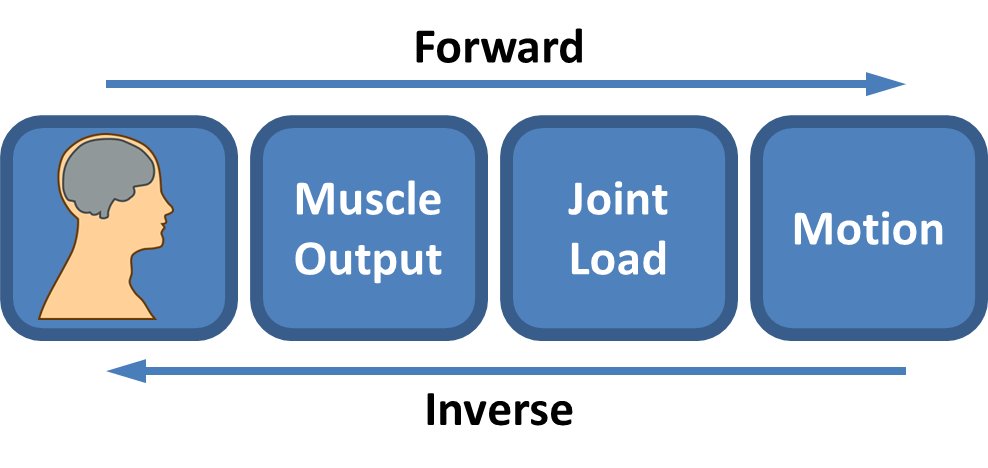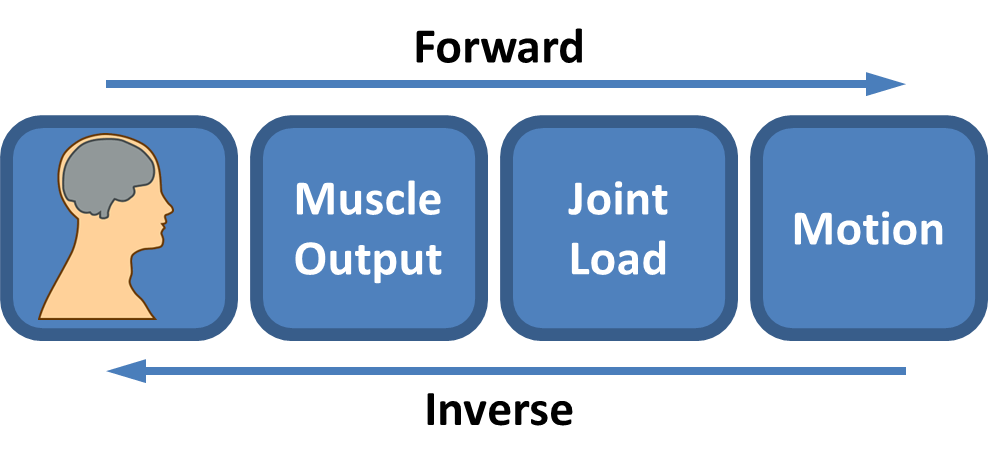A More Forward Approach to Understanding Pitching Biomechanics

This is part two of three of the initial guest posts by Dr. James Buffi. Part one was titled Challenges with Typical Biomechanical Analyses of Pitching.
It is impossible to figure out if a specific player scored a run in a baseball game just by looking at the final box score. This is essentially what typical biomechanical analyses of pitching try to do. They attempt to infer the underlying outcome for the UCL from macroscopic surface-level observations of net elbow loading.
As stated in my previous post, the total elbow load is not nearly enough information to determine the underlying ligament load.
Most of these typical biomechanical analyses can be classified as inverse dynamic analyses. The word “inverse” refers to the order in which calculations are performed relative to the way the body actually creates motion. In an inverse dynamic analysis, the total joint loads are recorded and calculated first. The loads on individual joint structures and muscles are then computed second. This directly contrasts the way the human body actually creates motion.
In the human body, the muscles are generally activated first by the brain. A motion then occurs second, as a result of the activation. When an analysis of a motion is performed by working “forward” from neural command, to muscle output, to joint loading, and then to the motion, it is called a forward dynamic analysis. In a forward analysis, a motion is analyzed in the same way the body creates it, as opposed to the inverse approach, in which the analysis starts with the end result and works backwards.
Referring back to the example I used in my first post, let’s again consider the situation in which two teams of 15 people are playing a game of tug-of-war. To perform an inverse analysis of the game, the total load on the rope is measured first, and then the loads supported by individual players are estimated second from the total rope load.
In contrast, to perform a forward analysis of tug-of-war, one would start by determining the loads supported by individual players, and then calculate the total rope load that results. The forward analysis better represents the observed process. It does not require approximating a method for working backwards from the load on the rope to the underlying loads supported by specific individuals.
When I perform a biomechanical analysis of a pitcher, I use a more forward approach. I go straight to the muscles and ligaments. To be clear, I do not perform a forward dynamic analysis in the purest sense, because my approach still begins with the recording of the pitching motion rather than the neural command. However, I do not calculate the total joint loading as an intermediate step. I compute the actions of the muscles and ligaments directly from the pitcher’s motion using knowledge of musculoskeletal anatomy and neural activation patterns. I am able to accomplish this with computational, physics-based, musculoskeletal-modeling techniques.
The development of my computational approach began while I was working toward my PhD. I used a computer model of the human body and a well-defined algorithm [1] to compute muscle forces that generated a recorded pitching motion. The algorithm included an embedded forward dynamic analysis. The specific computer model I used was developed from bone, muscle, and ligament geometry measurements taken in cadavers, as well as strength measurements taken in living subjects [2, 3].
In 2014, I published an academic article using my modeling approach [4]. In this study, titled “Computing Muscle, Ligament, and Osseous Contributions to the Elbow Varus Moment During Baseball Pitching,” I created a computer simulation of a high school pitcher’s throwing motion. I then used the simulation to investigate how individual muscles can affect UCL loading. I also investigated how changes in muscle output can either relieve or exacerbate the load on the UCL.
My simulation results supported what many people have postulated over the years: muscles have the ability to substantially influence the load on the UCL [5-7]. As expected, my simulation results showed that the forearm flexor-pronator muscles have the capacity to generate considerable protective elbow forces. Surprisingly, due to the subject’s specific posture at the time of maximum elbow loading in his pitching motion, I also found that the triceps muscles were able to protect the subject’s UCL. This may not hold for every pitcher, but it is definitely worth exploring.
Additionally, when I increased the outputs of all the subject’s muscles in a simulation (as one could theoretically do using a well-defined training regimen), I was able to eliminate the simulated load on the subject’s modeled UCL.
This is an awesome result. It implies that pitchers can protect their elbows through muscle training. It implies that changes to throwing mechanics are not always necessary for injury prevention. However, it is important to understand that it only occurred in one simulation of one motion with certain muscles isolated. More work is needed before this result can be applied in the training room or on the practice field. The potential to get this work done is just one of the many reasons why I am excited to work with Kyle Boddy here at Driveline. He believes in using scientific evidence to support advanced training techniques.
The most important outcome of my 2014 study, which became the crux of my doctoral dissertation, is that I developed a framework for subject-specific muscle-driven analyses of pitching. This means that I can now record a specific pitcher’s throwing motion and give him a legitimate analysis of what is going on with his muscles and ligaments, in a way that has never been done before.
In fact, this more forward approach is already generating new and exciting research outcomes. Using this approach, I have observed notable differences between the muscle and ligament actions of previously injured and non-injured pitchers (which I hope to publish within the next year). If I am able to develop tests that detect specific differences such as these, there is great potential to identify injury-prone pitchers before they get injured. Furthermore, there is the potential to design training programs that compensate for observed differences and protect vulnerable muscles and ligaments.
The current state of baseball speaks volumes. Elbow injury rates are so severe that teams feel like they are running out of options. Certain teams are even seriously considering six-man rotations. Now I think it’s time for baseball to embrace a more forward approach to pitching injury prevention.
Dr. James H. Buffi has a degree in mechanical engineering from the University of Notre Dame and a PhD in biomedical engineering from Northwestern University. His doctoral dissertation was called, “Using Biomechanical Modeling and Simulation to Calculate Potential Muscle Contributions to the Elbow Varus Moment during Baseball Pitching.” He has also been a visiting scholar in the National Center for Simulation in Rehabilitation Research at Stanford University as well as a visiting researcher at Massachusetts General Hospital. You can follow @jameshbuffi on twitter.
References:
- Thelen, D.G., F.C. Anderson, and S.L. Delp, Generating dynamic simulations of movement using computed muscle control. Journal of Biomechanics, 2003. 36(3): p. 321-328.
- Holzbaur, K.R.S., et al., Moment-generating capacity of upper limb muscles in healthy adults. Journal of Biomechanics, 2007. 40(11): p. 2442-2449.
- Holzbaur, K.R.S., et al., Upper limb muscle volumes in adult subjects. Journal of Biomechanics, 2007. 40(4): p. 742-749.
- Buffi, J.H., et al., Computing Muscle, Ligament, and Osseous Contributions to the Elbow Varus Moment During Baseball Pitching. Ann Biomed Eng, 2014.
- Lin, F., et al., Muscle contribution to elbow joint valgus stability. Journal of Shoulder and Elbow Surgery, 2007. 16(6): p. 795-802.
- Seiber, K., et al., The role of the elbow musculature, forearm rotation, and elbow flexion in elbow stability: an in vitro study. Journal of Shoulder and Elbow Surgery, 2009. 18(2): p. 260-8.
- Udall, J.H., et al., Effects of flexor-pronator muscle loading on valgus stability of the elbow with an intact, stretched, and resected medial ulnar collateral ligament. Journal of Shoulder and Elbow Surgery, 2009. 18(5): p. 773-778.
Want to learn more about biomechanics as it relates to throwing a baseball? Check out all the articles we’ve written that deal with throwing mechanics!
Comment section
Add a Comment
You must be logged in to post a comment.


How Muscles Work and Protect a Pitcher -
[…] I dive in, if you missed part one or two of the three part introduction to my views on the biomechanics of pitching, here
From 77mph to 90mph in Five Months - The Joe Marsh Story -
[…] throw, and a place to get better. But Driveline Baseball is much more; Kyle implements methods of biomechanics and new training and throwing programs that I had never heard […]
Why Sir Isaac Newton is Still the Foremost Expert in Pitching Biomechanics - Driveline Baseball -
[…] As I’ve said before, for a specific pitcher, it remains unclear how much force is felt specifically by the UCL during each individual pitch. Researchers have attempted to gain a better understanding of UCL loading during pitching by calculating the total force load on the elbow under a variety of conditions. They’ve done this using an approach called inverse dynamics. […]